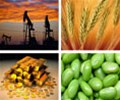

Earlier this month, as a bulk carrier that set sail from Chile in South America docked at a terminal of the Zhangjiagang Port in eastern China’s Jiangsu province, Qian Jiang directed scores of workers unloading the cargo to ensure all 10,000 metric tons of the copper concentrate could be scraped clean to the last milligram.
The unloading process took over three-and-a-half hours to complete.
Qian, an executive from the quality control center of Tongling Nonferrous Metals Group Co Ltd in Anhui province, was under instructions to treat the imported copper concentrate as gold-precious because of the recent surge in commodity prices.
There is no margin for wastages these days in the commodities trade. Tongling Nonferrous Metals Group spent over 100 million yuan ($15.5 million) to import the copper concentrate, which is a raw material for copper.
Prices of such commodities have surged by more than 50 percent globally over the past 12 months, creating unforeseen challenges for enterprises the world over, including those in China.
Like Tongling Nonferrous, Chinese companies across industries are leaving no stone unturned to remain competitive in a tough global market environment.
Surging commodity prices were a potential double whammy, or an Aliesque one-two knockout punch, for many of the COVID-savaged enterprises. For, most businesses’ fortunes are linked directly or indirectly to prices of commodities or raw materials.
In response, they have been adopting a variety of strategies to survive and thrive amid arguably impossible conditions. Some have embraced e-commerce and high-tech, others have digitalized their operations for the first time, while a few others explored soft power, supply chain restructuring, new partnerships to boost trade, and business promotion and brand-building activities like participation in expos.
By mid-June, signs emerged that such measures may be paying off. What’s more, the price surge has not shrunk demand-import volumes kept growing through the period of soaring prices.
For instance, China’s total import volume of copper ores and concentrates reached 9.83 million tons in the first five months of this year, up 6.4 percent year-on-year.
Similarly, imports of unwrought copper and copper materials jumped 8.4 percent to 2.37 million tons, data from the General Administration of Customs showed.
“Driven by growing demand in the export market, and in infrastructure and industrial sectors, Chinese companies have a big need for copper,” said Qian.
The domestic market expansion under the new dual-circulation development pattern has also provided great opportunities for export-oriented companies. They have been able to unearth more growth points in the vast domestic market.
China’s new development paradigm, a major strategy championed by Chinese President Xi Jinping, sees domestic and overseas markets reinforcing each other, with the domestic market as the mainstay.
During his inspection tour of Northwest China’s Qinghai province earlier this month, Xi also called for fostering a policy environment that encourages, supports and guides the development of private enterprises, as well as coordinating the development of industries and enterprises with efforts for boosting employment.
Even though the prices of commodities have surged notably since the second half of last year, Amico Group Co Ltd, a Ningbo, Zhejiang province-based private valve and faucet manufacturer, has continued to import over 1,000 tons of copper and related products on a monthly basis, driven by the stable growth in its business orders this year.
“Owing to the surge in domestic consumers’ demand for quality daily necessities in recent years, sales of copper products have increased significantly. So, we have shifted our business from 100 percent exports to 80 percent domestic sales,” said Zhou Guoxiang, the group’s vice-president.
The company’s sales in the home market reached more than 400 million yuan, or around $62 million, in the first quarter of this year, while its exports exceeded $20 million.
“Since our foreign trade and domestic sales have both increased by 40 percent year-on-year from January to May this year, the growth pattern of boosting domestic sales to drive foreign trade has already taken shape,” he said.
Although many Chinese companies have already increased their output to ensure the smooth running of their overseas sales networks, they are facing the pressure of growing commodity, labor and shipping costs, said Chen Zhongda, deputy head of Yinzhou Customs, a branch of Ningbo Customs in Zhejiang province.
“Bulk commodity price rises gained momentum in the fourth quarter of last year, and this trend has accelerated this year as consumption outpaced supply,” he said, adding that quantitative easing measures in many countries have also generated liquidity and boosted commodity prices.
To cope with anticipated heightened pressure in the second half of this year due to increasing commodity prices, skyrocketing shipping costs and a fluctuating foreign exchange rate, Beifa Group, a leading stationery and office supplies manufacturer based in Ningbo, has adopted a strategy used by many other export-oriented companies.
Source: China Daily